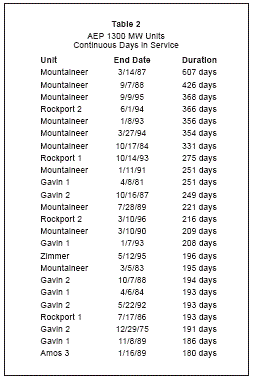Supercritical (Once Through)
Boiler Technology
Автор: J.W. Smith
This paper provides an overview of the Babcock & Wilcox (B&W) Once Through Boiler Technology. This review includes the history of the boiler development beginning with the world’s first ultra-supercritical steam system, which began operation at the Ame r i c an El e c t r i c Powe r (AEP) Phi lo St a t ion in 1957, through the development of the world’s largest boilers, the pulverized coal fired 1300 MW class. The most recent of the 1300 MW units began operation in 1990 at the Zimmer Power Station jointly owned by Cincinnati Gas & Electric, Dayton Power & Light and American Electric Power. The design features of this boiler style, which is designed for base load and load cycling operation, are discussed.
Once through boilers have long been the vision of boiler design engineers. In the United States, patents for once through boiler concepts date from as early as 1824. These early inventors were undoubtedly motivated by the desire to improve the product safety because of the notoriety of pressure vessel failures associated with the early fire tube and water tube boilers. While advances in the boiler industry in the late 1800s such as the developments by The Babcock & Wilcox Company (founded in 1867) significantly improved product safety, interest continued in the development of once through boilers both as a way to eliminate the need for the steam drum and with the hope that the design would better cope with impurities contained in the water. B&W’s research in once through boilers dates from 1916 when boiler research was begun at the company’s Bayonne, New Jersey Laboratory. In keeping with the technology of the time, this early research unit was operated at a pressure of 4 MPa. The first significant commercial application of once through boilers was made by Mark Benson, a Czechoslovakian inventor, when he in 1923 provided 4 ton/hr unit for English Electric Co., Ltd. at Rugby, England. This unit was designed to operate at critical pressure with the belief that operating at this pressure, where there is not density difference between steam and water, would avoid boiler tube overheating and solids deposition. Mark Benson continued his development work which included the installation in 1930 of a 113 ton/hr unit in Belgium.
Like the unit for English Electric, this unit was intended to operate at critical pressure. The hoped elimination of problems by operating at critical pressure, however, was not fulfilled and it was necessary to reduce the boiler operating pressure to overcome probl ems wi th tube f a i lur e s . In thi s c a s e , the boi l e r inventor’s vision outreached the technology available at this time for both tube materials and water chemistry control. Nonetheless, these early units were successful in operation and served as the foundation for the boiler development work that set the direction for European boiler development. Mark Benson’s concepts were ultimately acquired by Siemens and it is from these concepts that the Benson Boiler Technology now licensed worldwide by Siemens was developed.
B&W also continued with
their experimental work on once through boilers in the 1920s as boiler
and power plant engineers envisioned the efficiency gains that could be
achieved by the use of ultra supercritical pressure cycles. B&W
in 1928 began experimental work at its research center in a test
facility
capable of operation at 34.5 MPa and 520C. This test facility was used
to examine thermal-hydraulic and heat transfer effects in the pressure
range from 10 MPa to the maximum operating pressure of the unit. The
test rig was then transferred to Purdue University where research
continued in collaboration with B&W.
Much of this work was reported in Technical Papers in the early 1930s by authors such as Kerr and Potter. Through the 1930s and 1940s power plant operating conditions were limited to the subcritical regime because of limitations of metallurgy and water chemistry control technology. In Europe, boiler technology followed the once through philosophy. This at least in part was driven by material availability constraints and took advantage of the fact that the once through boiler generally used smaller diameter and thinner walled tubes then did the natural circulation boiler. In addition, the once through boiler eliminated the need for thick steel plate for the steam drum. In the United States where material was more readily available, the technology continued to rely on the natural circulation boiler design. In both Europe and the United States, the steam cycles used had similar steam conditions resulting in similar power generation efficiencies. For example, as early as 1941 B&W had supplied boilers to American Electric Power for operation at 16 MPa.
The era following the second World War brought on rapid economic development in the United States. The rapid economic development increased the desire for more efficient power plant operation. This, coupled with the improvements in both boiler tube metallurgy and water chemistry technology, brought a renewed interest in the supercritical cycle. B&W increased its research work and in 1951 established another 34.5 MPa heat transfer test facility at its Alliance (Ohio) Research Center. In addition, to assimilate the European once through boiler technology, B&W established a working relation with the then Siemens-Schuckertwerke Company, the holder of the Benson technology, and the Durrwerke Company, at the time the builder of the more boilers than any other Benson licensee, both of Germany. While the European experience was all for subcritical cycles, this technology transfer was invaluable in accelerating B&W’s development of the supercritical application.
The vision of the supercritical power plant was also held by American Electric Power and General Electric (for the steam turbine). American Electric Power entered into contract with both B&W and General Electric to build the world’s first ultrasupercritical power plant. This 125 MW installation at the Philo Plant operated at main steam condition of 31 MPa and 621C with two stages of reheating first to 565C and then to 538C.
The decision to proceed with
this plant was made in 1953 and operation was begun in 1957. While the
intent of the plant was to demonstrate the feasibility of the
supercritical pressure cycle, this unit was commercially operated until
1979. The boiler used B&W’s cyclone firing technology
and was
equipped with three cyclone furnaces. The boiler arrangement, shown in
Figure 1, is based on horizontal gas flow over the majority of the
convection heat transfer surfaces. This arrangement is quite different
than the typical boiler arrangement of today, but was very similar to
the natural circulation boiler arrangements of the time, such as the 90
MW, 10 MPa boiler shown in Figure 2. The furnace tube arrangement was
quite differentfrom that used in boilers of the Benson technology
design. The Benson technology boilers, because they were designed for
operation in the subcritical regime, made use of the meandering tube
arrangement where the tubes passed completely around the furnace
enclosure as a means of obtaining more uniform heat absorption from
tube to tube. This construction was necessary for the subcritical
design as a means to minimize the temperature difference between tubes.
The meandering tube design used the refractory and skin casing
construction.
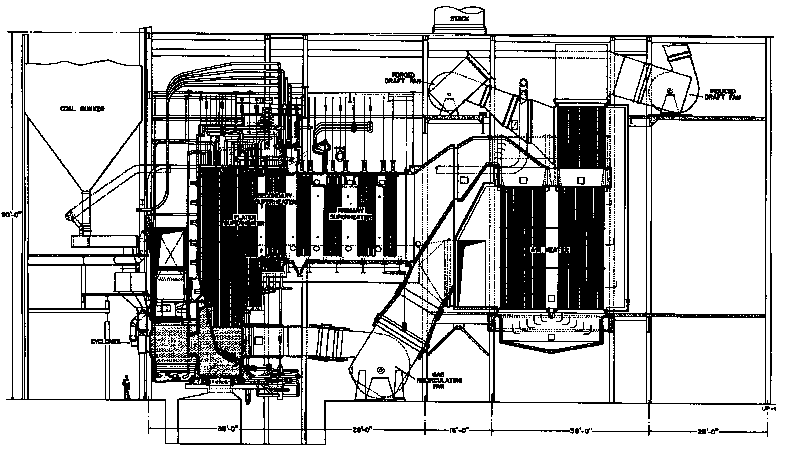
Since the Philo unit operated in the supercritical regime, the concern for differential heat absorption and the resulting impact on tube temperature difference was not nearly as great. Therefore, this unit was designed with vertical tubes following the construction techniques already employed in natural circulation boilers. Following the practice of United States boiler construction, the design made use of partial membraning to minimize the amount of refractory and skin casing. In order to obtain the necessary mass flux within the tubes to provide adequate heat transfer and tube cooling, a multiple pass arrangement was adopted. Because the unit was intended only for operation in the supercritical regime, this design strategy was successful.
The rapid development of the B&W once through boiler paralleled the rapid expansion of the United States Utility Industry in the 1960s and 1970s. The second and third boiler contracts were also with American Electric Power, but these 450 MW systems were ordered before the Philo unit went into service. Both boilers are tower style designs since it was recognized that the horizontal style of the Philo design could not lend itself to larger sizes (See Figure 3). The second contract, for the Breed Station was cyclone fired while the third contract, for the Sporn Station was pulverized coal fired reflecting the difference in coal characteristics. The steam conditions were reduced somewhat from the Philo unit to 24 MPa with main steam temperature of 565C and two stages of reheat to 565C. By the fourth contract, a 250 MW subcritical oil and gas fired units for Southern California Edison, the design had evolved to the Carolina configuration used today for both once through and drum type pulverized coal fired boilers (Figure 4). The rapid evolution of size is shown in Table 1. Just 12 years after the 125 MW unit began operation, the 1150 MW unit for Tennessee Valley Authority began operation and a few years later the first of the 1300 MW series, also for Tennessee Valley Authority, began operation. As noted earlier, the ninth of the 1300 MW series beganoperation at the Zimmer Power Plant in 1990. B&W has suppled 89 supercritical boilers with an installed capacity of 60,000 MW including 42,000 MW firing coal.
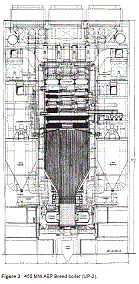
This chart in many ways reflects the trend in the United States utility industry. During the 1960s there was rapid growth in power plant size with most of the large units being the supercritical cycle. As economic conditions changed in the early and mid 1970s the industry reverted to favoring the subcritical steam cycle using the natural circulation drum boiler due to the lower installed cost of the subcritical plant. While the supercritical cycle was more efficient, this efficiency improvement did not justify the increased capital cost under the economic constraints imposed upon the utilities. With the decline in the United States economy into the 1980s the growth rate of electric power demand declined significantly and this caused a further change in the utility buying pattern as they could no longer justify the larger power plants (600 MW size and greater). The trend toward smaller size installations further impaired the economics of the supercritical steam cycle.
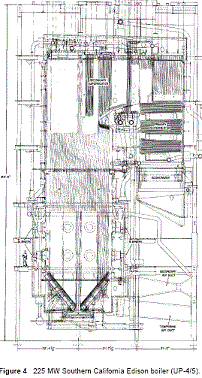
The supercritical Universal Pressure (UP) boiler was designed for base load and load cycling operation rather than for daily start/stop service. These design parameters met the market requirements since the supercritical plant would be the most efficient in the utility system and, therefore, the unit which economics would dictate should be base loaded. This design criteria had a strong influence on the furnace arrangement. The 1300 MW capacity unit for the Zimmer station serves as an example for discussion. This boiler, shown in Figure 5, is similar in arrangement to all the supercritical UP boilers. While this boiler is of recent vintage, its overall design philosophy follows the other 1300 MW units which originated in the late 1960s. Compared to today’s design criteria, this boiler has a rather small furnace and relies on recirculation of flue gas from the economizer exit to the upper portion of the furnace (called gas tempering) as a way to reduce the furnace exit gas temperature and thereby control the slagging and fouling potential at the higher operating loads. The recirculated flue gas is also introduced to the furnace hopper (gas recirculation) to control furnace heat absorption at reduced loads and, thereby, control the reheat steam temperature. In designing a new boiler for the Chinese market today, the design would follow the generally accepted design parameters for Chinese coals and would, of course, not use flue gas recirculation. The reheat steam temperature control would instead be provided by dampers within parallel gas flow paths.
Note that the general arrangement of the gas side of the once through boiler is quite similar to that of the natural circulation boiler, such as the 600 MW boilers, shown in Figure 6, now under construction for the Jiangsu Provincial Electric Power YangZhou station. This is not surprising since the design arrangement is determined by the coal parameters and by economic construction parameters.
Since the supercritical UP
boiler was intended for base load operation and load cycling operation,
the constraint that the boiler furnace be operated only above the
critical pressure point was placed on the design. This constraint plus
the thermal dynamic properties of steam lead to the water circuit
design. The water provided by the boiler feed pumps and flowing through
the high pressure feedwater heaters first flows through the economizer
located in the conventional location in the convection pass. Water from
the economizer discharge then flows through the connecting pipe (or
first pass downcomer to the
lower portion of the furnace). In order to obtain the high mass flux
necessary for efficient tube cooling, the lower portion of the furnace
(to a point approximately mid way between the upper level of burners
and the furnace nose) is made up of two sequential water flow paths
which are physically arranged in parallel around the furnace
circumference. These two paths are formed by alternating first pass and
second pass tubes around the boiler perimeter. As shown in Figure 7,
water flows up the first path to outlet headers, out to a mix system
where the fluid enthalpy from all the first pass tubes is equalized,
down another downcomer to the second pass inlet at the bottom of the
furnace and then up the second pass tubes exiting again in outlet
headers. The water then flows through enthalpy equalization mix headers
and back into the third pass tubes with the third pass making up the
entire perimeter of the upper furnace.
Thus, in the lower heat flux zone of the upper furnace, the tube mass flux is reduced to approximately half that of the lower furnace for economy of pressure loss.
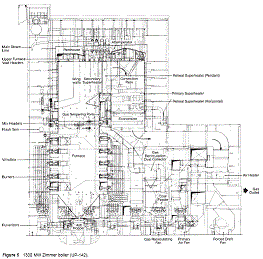
Figure 8 shows the temperature-enthalpy diagram and boiler state conditions for the Zimmer boiler at full load operation. Note that in the first and second passes of the furnace the temperature changes very little for significant changes in enthalpy.
Therefore
the first and second pass tubes operate at near the same temperature
making the alternating tube construction possible and, in fact,
desirable as a way to make the overall furnace expansion more uniform.
In addition to providing the higher mass flux needed in the higher heat
flux zone of the lower furnace,this multiple pass arrangement also
minimizes the temperature upset due to heat absorption upset. The heat
absorption profile varies around the furnace perimeter (especially
being lower near the furnace corners) and the heat flux distribution is
ever changing as a result of furnace slagging changes.
Thus, the design does recognize that some tubes within the furnace
absorb greater heat than other tubes. This increased heatabsorption has
a double effect on temperature within the tube since, with the high
mass flux, the flow rate within the tube also decreases, with respect
to other tubes, as the heat flux increases.

Thus, the mix location between the burners and furnace arch is selected to hold the theoretical maximum temperature upset among adjacent tubes to the proven design value. Figure 9 shows this effect of heat upset on individual tube temperature as well as the function of the mix sections for enthalpy equalization. As discussed earlier, the supercritical UP boiler design requires that the fluid pressure within the furnace tubes must remain above the critical pressure at all times. If this provision is not met and the pressure falls into the subcritical regime a steam water mixture would be present entering the second pass of the furnace, as shown on the temperature enthalpy diagram. As a result of this two-phase condition steam-water separation can occur so that the fluid at the inlet of some tubes of the second pass will contain a greater steam fraction than will other tubes.
Because of the large density difference between the steam and the water, the flow will be restricted in the tubes receiving the greater steam fraction so that these tubes will overheat and fail. Therefore, in order to take advantage of the beneficial effects of variable pressure turbine operation during load turndown, pressure control division valves are located within the boiler between the primary and secondary superheaters. These valves maintain the furnace fluid pressure above the critical point while letting the turbine follow its most economical pressure versus load operating profiles. With partial arc admission turbine designs, the most economical operating condition is consistent pressure operation to the second valve point typically at between 60 and 70% load.
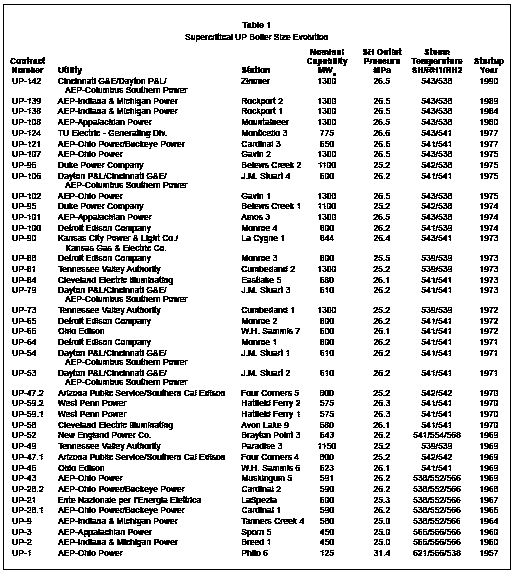
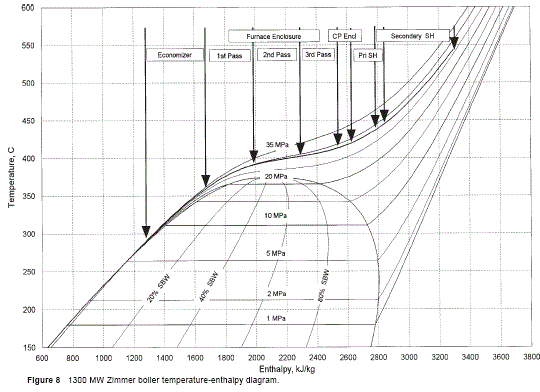
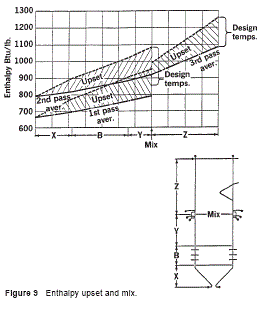
The resulting boiler pressure
and turbine pressure operating characteristics are shown in Figure 10.
While the requirement for the furnace to remain above the critical
pressure point means that the pump power reduction associated with
variable pressure operation is not realized, the partial arc admission
characteristic of the turbine means that there is very little penalty
due to the pump power down to approximately 50% load. In the United
States, most once through boilers are normally operated in a load
cycling mode and the UP boiler design performs very well in such
service.

For example, the six 1300 MW boilers operated by American Electric Power (the Zimmer boiler is operated by Cincinnati Gas & Electric) are normally operated in a load cycling duty with maximum load during the middle of the day and a reduction to 40% load at night. The weekly load profile for two of the 1300 MW units is shown on Figure 11. This load cycle closely follows the American Electric Power system load requirements.
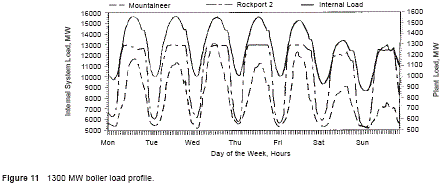
This load cycling operation is necessary even for the 1300 MW units because a large portion of the American Electric Power System is supplied by once through boilers with the other sizes being 600 MW and 800 MW. The excellent reliability of the UP design, and of the 1300 MW class plant, is demonstrated by the AEP Mountaineer plant which set a world record of 607 consecutive days (from July 14, 1985, to March 14, 1987) of operation without shutting down. The shut down at the end of this record setting period was for a scheduled maintenance inspection. Each of the AEP 1300 MW units has demonstrated impressively long continuous operating runs as shown in Table 2. These long continuous operating runs testify to the high reliability of the boiler design. Because of this high reliability, AEP now schedules minor maintenance outages at 2 year intervals and major maintenance outages at 4 year intervals.
